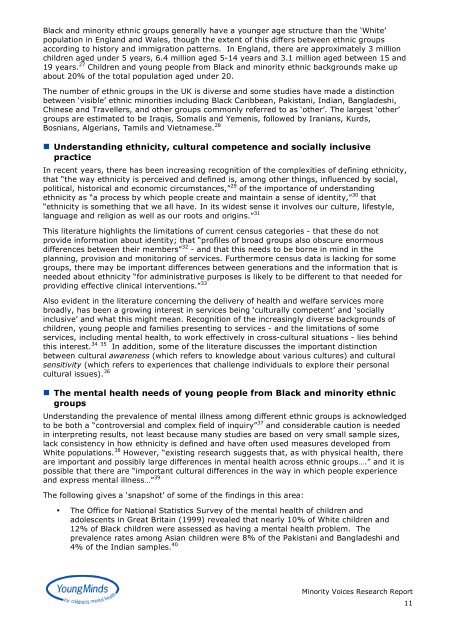Minority voices: Research into the access and acceptability of ... - MMC
Minority voices: Research into the access and acceptability of ... - MMC
Minority voices: Research into the access and acceptability of ... - MMC
- No tags were found...
Create successful ePaper yourself
Turn your PDF publications into a flip-book with our unique Google optimized e-Paper software.
Black <strong>and</strong> minority ethnic groups generally have a younger age structure than <strong>the</strong> ‘White’population in Engl<strong>and</strong> <strong>and</strong> Wales, though <strong>the</strong> extent <strong>of</strong> this differs between ethnic groupsaccording to history <strong>and</strong> immigration patterns. In Engl<strong>and</strong>, <strong>the</strong>re are approximately 3 millionchildren aged under 5 years, 6.4 million aged 5-14 years <strong>and</strong> 3.1 million aged between 15 <strong>and</strong>19 years. 27 Children <strong>and</strong> young people from Black <strong>and</strong> minority ethnic backgrounds make upabout 20% <strong>of</strong> <strong>the</strong> total population aged under 20.The number <strong>of</strong> ethnic groups in <strong>the</strong> UK is diverse <strong>and</strong> some studies have made a distinctionbetween ‘visible’ ethnic minorities including Black Caribbean, Pakistani, Indian, Bangladeshi,Chinese <strong>and</strong> Travellers, <strong>and</strong> o<strong>the</strong>r groups commonly referred to as ‘o<strong>the</strong>r’. The largest ‘o<strong>the</strong>r’groups are estimated to be Iraqis, Somalis <strong>and</strong> Yemenis, followed by Iranians, Kurds,Bosnians, Algerians, Tamils <strong>and</strong> Vietnamese. 28! Underst<strong>and</strong>ing ethnicity, cultural competence <strong>and</strong> socially inclusivepracticeIn recent years, <strong>the</strong>re has been increasing recognition <strong>of</strong> <strong>the</strong> complexities <strong>of</strong> defining ethnicity,that “<strong>the</strong> way ethnicity is perceived <strong>and</strong> defined is, among o<strong>the</strong>r things, influenced by social,political, historical <strong>and</strong> economic circumstances,” 29 <strong>of</strong> <strong>the</strong> importance <strong>of</strong> underst<strong>and</strong>ingethnicity as “a process by which people create <strong>and</strong> maintain a sense <strong>of</strong> identity,” 30 that“ethnicity is something that we all have. In its widest sense it involves our culture, lifestyle,language <strong>and</strong> religion as well as our roots <strong>and</strong> origins.” 31This literature highlights <strong>the</strong> limitations <strong>of</strong> current census categories - that <strong>the</strong>se do notprovide information about identity; that “pr<strong>of</strong>iles <strong>of</strong> broad groups also obscure enormousdifferences between <strong>the</strong>ir members” 32 - <strong>and</strong> that this needs to be borne in mind in <strong>the</strong>planning, provision <strong>and</strong> monitoring <strong>of</strong> services. Fur<strong>the</strong>rmore census data is lacking for somegroups, <strong>the</strong>re may be important differences between generations <strong>and</strong> <strong>the</strong> information that isneeded about ethnicity “for administrative purposes is likely to be different to that needed forproviding effective clinical interventions.” 33Also evident in <strong>the</strong> literature concerning <strong>the</strong> delivery <strong>of</strong> health <strong>and</strong> welfare services morebroadly, has been a growing interest in services being ‘culturally competent’ <strong>and</strong> ‘sociallyinclusive’ <strong>and</strong> what this might mean. Recognition <strong>of</strong> <strong>the</strong> increasingly diverse backgrounds <strong>of</strong>children, young people <strong>and</strong> families presenting to services - <strong>and</strong> <strong>the</strong> limitations <strong>of</strong> someservices, including mental health, to work effectively in cross-cultural situations - lies behind34 35this interest. In addition, some <strong>of</strong> <strong>the</strong> literature discusses <strong>the</strong> important distinctionbetween cultural awareness (which refers to knowledge about various cultures) <strong>and</strong> culturalsensitivity (which refers to experiences that challenge individuals to explore <strong>the</strong>ir personalcultural issues). 36! The mental health needs <strong>of</strong> young people from Black <strong>and</strong> minority ethnicgroupsUnderst<strong>and</strong>ing <strong>the</strong> prevalence <strong>of</strong> mental illness among different ethnic groups is acknowledgedto be both a “controversial <strong>and</strong> complex field <strong>of</strong> inquiry” 37 <strong>and</strong> considerable caution is neededin interpreting results, not least because many studies are based on very small sample sizes,lack consistency in how ethnicity is defined <strong>and</strong> have <strong>of</strong>ten used measures developed fromWhite populations. 38 However, “existing research suggests that, as with physical health, <strong>the</strong>reare important <strong>and</strong> possibly large differences in mental health across ethnic groups….” <strong>and</strong> it ispossible that <strong>the</strong>re are “important cultural differences in <strong>the</strong> way in which people experience<strong>and</strong> express mental illness…” 39The following gives a ‘snapshot’ <strong>of</strong> some <strong>of</strong> <strong>the</strong> findings in this area:• The Office for National Statistics Survey <strong>of</strong> <strong>the</strong> mental health <strong>of</strong> children <strong>and</strong>adolescents in Great Britain (1999) revealed that nearly 10% <strong>of</strong> White children <strong>and</strong>12% <strong>of</strong> Black children were assessed as having a mental health problem. Theprevalence rates among Asian children were 8% <strong>of</strong> <strong>the</strong> Pakistani <strong>and</strong> Bangladeshi <strong>and</strong>4% <strong>of</strong> <strong>the</strong> Indian samples. 40<strong>Minority</strong> Voices <strong>Research</strong> Report11
















